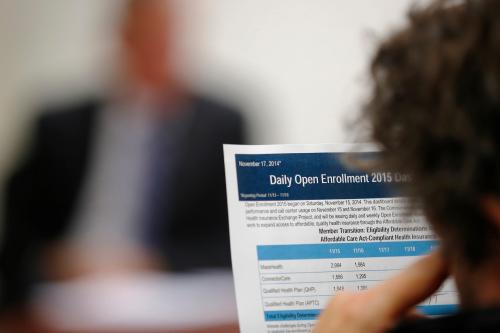This analysis is part of The Leonard D. Schaeffer Initiative for Innovation in Health Policy, which is a partnership between the Center for Health Policy at Brookings and the USC Schaeffer Center for Health Policy & Economics. The Initiative aims to inform the national health care debate with rigorous, evidence-based analysis leading to practical recommendations using the collaborative strengths of USC and Brookings. The article originally appeared in Health Affairs on April 12, 2017.
Before Congress recessed last week, the House of Representatives wanted to show some progress in reforming health care, so they left an early Easter surprise: an amendment to the pending American Health Care Act (AHCA) proposing an “Invisible Risk Sharing Program,” funded with $15 billion over 9 years. According to all-knowing Google, this phrase first surfaced just a few weeks ago when Rep. Palmer (R-AL) introduced an earlier (and more specific) version of the amendment, based on ideas developed here.
Prospective v. retrospective
Despite its novel title, the program embodies an idea that has circulated in obscure health policy circles for a quarter century: a behind-the-scenes reinsurance program for higher-risk subscribers whom insurers identify at the point of enrollment. This new (old) approach works differently from the “retrospective” reinsurance that the Affordable Care Act (ACA) used for its first three years. Under the ACA, insurers were reimbursed for enrollees who turned out to be especially expensive (initially, more than $45,000 in a year). Invisible risk sharing, in contrast, requires insurers to identify in advance which people they believe will incur large claims, and “cede” them (and their premiums) to a high risk pool, funded by both insurers and the government. The pool then pays all the medical costs for these ceded “lives” (people) beyond a somewhat lower threshold (e.g., $10,000).
Either form of reinsurance – AHCA’s prospective or the ACA’s retrospective – is “invisible” in the sense that high-cost subscribers are unaware of its existence. And both types of reinsurance use public funds to lower insurers’ costs and thus reduce premiums. Where the two programs differ is that AHCA’s invisible risk sharing pays nothing for people who unpredictably incur large claims.
Where the two programs differ is that AHCA’s invisible risk sharing pays nothing for people who unpredictably incur large claims.
Neither approach is inherently superior at reducing premiums. Premium reduction depends entirely on how much funding the program receives in relation to the risks being insured. Rep. Palmer’s amendment leaves all the critical details of the new, invisible program unspecified, making it hard to generate precise estimates. But, its $1.7 billion per year funding is no more than 2 percent of total premiums in the market. Whether these funds are injected at the front end, the back end, or in the middle, there is no alchemistic wizardry that can magically make more risk than this simply melt away.
That being the case, what should we make of claims that, wondrously, this approach caused premiums to plummet in Maine, and can make a big dent nationally?
Maine’s program
In 2011 Maine adopted a prospective reinsurance program for its struggling individual market, which, prior to the ACA, had guaranteed issue and community rating, but no subsidy or purchase mandate. The program was funded by a $4 per person per month levy on all forms of health insurance, including large groups and self-insured employers. That brought $21 million into the individual market to subsidize the costs for subscribers whom insurers identified as high risk. “High risk” was determined based on having one of eight prior diagnoses (congestive heart failure, HIV, COPD, kidney failure, various cancers), or based on information the insurer collected from applicants through a detailed medical questionnaire.
Proponents of this approach claim that it cut premiums in half. Closer analysis, however, undermines this claim. Two other changes happened at the same time. First, covered benefits became much less generous. For instance, the new, reinsured policies required 30 percent coinsurance and increased out-of-pocket maximums two-fold or more; also, maternity coverage was dropped entirely. Those changes contributed substantially to the price reduction.
Second, Maine expanded its age-rating bands from 1.5-to-1 to 3-to-1, but only for the new policies and not for legacy subscribers who chose to keep their old policies. Predictably, older, sicker subscribers kept what they had because they continued to benefit from tighter community rating, while younger ones who benefited from broader age bands migrated to the new reinsurance policies. This age separation was especially pronounced in Maine due to its having the oldest population in the U.S.
Thus, the nominal premium difference between Maine’s old and new policies tells us almost nothing about the impact of its reinsurance program. A better insight comes from an actuarial analysis done for the state, which noted that the $21 million subsidy amounted to 12-15 percent of the market’s total premiums. Also, actuaries at the state’s leading insurer (Anthem) estimated the first-year rate relief at about 20 percent. Much of that rate reduction is attributable to the especially high concentration of high risks Anthem had previously accumulated. In a market with more typical risk distribution, risk-sharing has a lesser impact on overall rates. Thus, Maine’s reinsurance board subsequently explained that its program has a “similar rate impact” as the ACA’s reinsurance program, which saved about 10 percent. And, more recently, the governing board noted that, were its program to restart now, its benefits would be “substantially reduced” because, under the ACA, the market has expanded three-fold.
Federal estimates
Beyond Maine, we can also look to the analysis that actuarial firm Milliman released on April 7, estimating the national impact of adding a Maine-like program to the ACA. Notably, the Milliman analysis takes the ACA as its baseline. It doesn’t estimate the effect of adding an invisible risk sharing program to the American Health Care Act, which jettisons the ACA’s subsidy structure. Still, the Milliman analysis gives us an all-else-being-equal, apples-to-apples estimate of what difference an invisible risk-sharing program might make. The short answer is: not a lot.
The Milliman report is complicated (as well-done actuarial analyses tend to be), but the key findings are summarized here and here. Our focus is on what Milliman labels “Scenario 2”, in which invisible reinsurance similar to Maine’s is applied to the existing ACA market, rather than creating two different markets side-by-side. In the single-market scenario, Maine’s program would reduce rates anywhere from 1-14%, depending on certain assumptions.
That sounds good, but the high-end reductions (4-14%) depend, critically, on one key assumption: that reinsurance pays claims only at Medicare rates, not commercial insurance rates, as Rep. Palmer initially proposed. It’s the reduction to Medicare rates that drives most of the savings—indeed, this accounts for three to four times more rate reduction than the pure reinsurance (risk pooling) aspect of the invisible risk-sharing program. But, the current House amendment presumably pays reinsured claims at normal commercial insurance rates (since it doesn’t say otherwise). Without the Medicare discount, Milliman projects that rates would be only 1-4% lower—substantially less than the 10% reduction created by the ACA’s reinsurance program.
Nevertheless, Milliman estimates that this premium reduction would increase coverage by roughly a million people (anywhere from 740,000 to 1.6 mill.)—again, assuming this became part of the existing ACA. But to achieve these premium reductions and coverage increases, Milliman estimates that the program would have to be funded at several times more than the $15 billion that the AHCA amendment appropriates over 9 years.
Risk adjustment
Invisible risk sharing involves more, however, than simply pumping more subsidies into the market. Because the program operates prospectively, it has the potential to shape insurers’ behavior more effectively than retrospective reinsurance. Requiring insurers to cover sick people at average market rates has been called an “unnatural act,” one that insurers tend to resist. Prospective reinsurance helps counteract insurers’ reluctance to enroll people who they think are likely to have high claims.
Thus a prospective approach is appealing where insurers have the ability to avoid the sick and unhealthy—but those conditions don’t hold under the ACA. The law prohibits insurers from discriminating on the basis of health status, and the evidence to date suggests that insurers aren’t competing over their ability to cherry-pick good risks or to lemon-drop bad ones.
That’s partly because the ACA’s risk adjustment program serves the same function of dulling insurers’ incentives to avoid sicker enrollees. Under risk adjustment, insurers with relatively healthier enrollees pay into a fund that then redistributes the money to insurers with relatively sicker enrollees. Thus, risk adjustment is a kind of prospective reinsurance scheme, albeit one that doesn’t depend on public funds.
The puzzle is that the Republican bill would layer prospective risk sharing on top of prospective risk adjustment. There’s no hint at why both are needed or how to coordinate the two. Conceivably, prospective (or “invisible”) risk-sharing could replace the ACA’s current risk adjustment program, which is by no means perfect. By combining prospective risk identification with additional public subsidies, this one program could serve two distinct functions: deterring insurers from risk avoidance, and reducing overall costs. Although that two-for-one replacement idea is not how the program is being presented, this is a possibility that merits further thought.
Past lessons
One way to assess the potential that invisible risk sharing has for improving competition conditions among insurers is to observe how this idea was used previously by states. In previous decades, a number of states created industry-funded prospective reinsurance as part of their initial reforms to the small group market. Most states quickly found that, without outside funding, simply pooling high risks among participating insurers made no real difference. States also discovered that prospective reinsurance is complex to administer. Thus, the idea was mostly abandoned, as shown here, based on research I did in 2006.
| Industry-Funded Reinsurance Pools for the Small Group Market | ||
|---|---|---|
| State | Year Enacted | Enrollment mid-2006 |
| Alaska | 1993 | Repealed |
| Connecticut | 1990 | >3,000 |
| Idaho | 1993 | 120 |
| Massachusetts | 1991 | Repealed |
| Missouri | 1992 | Repealed |
| Nebraska | 1994 | 20 |
| New Hampshire | 2005 | >600 |
| North Dakota | 1993 | Repealed |
| Vermont | 1991 | Never Implemented |
| Wyoming | 1992 | 30 |
Why resurrect the idea now, for the individual market? With government funding, it has more potential than the past experience. But the initial question remains: why use this more complex approach to publicly fund market stabilization?
Added Complexity
The complexity that states previously encountered is a huge problem for the Palmer amendment, because it asks HHS to ramp up the invisible risk-sharing program for the 2018 plan year. Insurers can’t afford to wait to see the details of whatever program HHS establishes. They need to know now what the rules will be for 2018.
One key reason is that, to assign people to an invisible risk pool based on their health status, insurers must collect health information from their enrollees. That means they have to reinstitute medical questionnaires from a bygone era of medical underwriting. Doing that undoubtedly would antagonize consumers. It would also require insurers to resurrect their underwriting tools in order to discern more accurately who they should and shouldn’t cede to the pool. When insurers cede subscribers, they also cede most (90%) of the premium, but they still have to pay the first tier of claims (e.g., $10,000). Because reinsurance kicks in only for amounts over that threshold, insurers will think carefully before ceding.
The program’s complexity can also be an ongoing headache for regulators. That’s one reason that Maine itself is likely to change to a simpler retrospective approach if it reinstates its reinsurance program: “a retrospective model seems to make the greatest sense due to its simplicity and higher level of predictability.” As the program’s consultant reported recently to the state:
A prospective model is significantly more complex to design and operate – both for [the government] and for carriers – than a retrospective model. While the prospective model requires both advance selection of auto-ceded conditions and significant underwriting activity by carriers, the retrospective model requires neither. [Maine’s] prior prospective model made ceding selections a part of the carriers’ standard underwriting process, while underwriting was eliminated with the ACA. This differential in complexity in itself is evidently a persuasive factor for some carrier members [of the program] as it would essentially require them to re-start the underwriting operations that have now been eliminated. Although there may be positive effects associated with the prospective model, those differences in result are difficult to quantify, and leave a key question for the Board – if we can achieve similar results with a less complex model, why pursue the more complex model?
Why indeed?
Conclusion
Suppose Congress were to increase the program’s funding enough to implement the approach in Maine, as Rep. Palmer initially proposed. A lot of people would agree that it’s good to bring many billions of dollars per year in additional subsidies into the individual market, and even better to pay for high-cost patients at Medicare rates. There is also strong support for making the ACA’s risk mitigation elements permanent, as they are under Medicare Part D, rather than primarily transitional, as they were under the ACA. The individual insurance markets in many states are fragile, and increased funding could help stabilize them. Moreover, a prospective approach to reinsurance could help deter insurers from engaging in covert risk selection.
The primary drawback is that this is an especially complicated mechanism for using public money to stabilize the private insurance market. Nevertheless, if assembling the political coalition to support effective market stabilization requires the adoption of invisible risk sharing, then perhaps it’s an option worth having in the basket of reform ideas. But, if like a hollow chocolate bunny, this approach lacks the necessary funding, biting in may greatly disappoint.
The authors did not receive financial support from any firm or person for this article or from any firm or person with a financial or political interest in this article. They are currently not an officer, director, or board member of any organization with an interest in this article.










Commentary
Making sense of “invisible risk sharing”
April 12, 2017